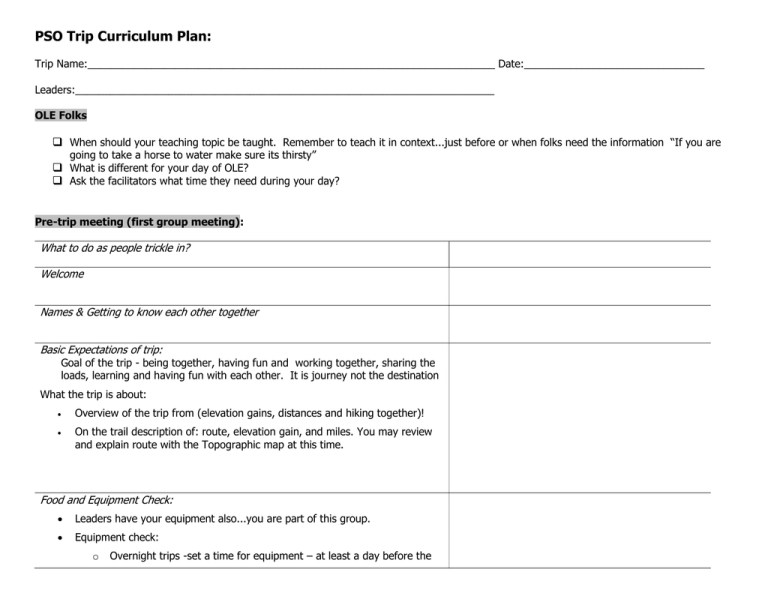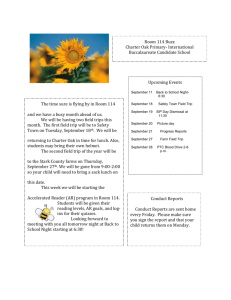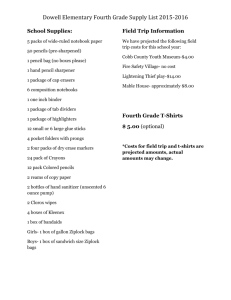PSO Trip Curriculum Plan:
advertisement

PSO Trip Curriculum Plan: Trip Name:______________________________________________________________________ Date:_______________________________ Leaders:________________________________________________________________________ OLE Folks When should your teaching topic be taught. Remember to teach it in context...just before or when folks need the information “If you are going to take a horse to water make sure its thirsty” What is different for your day of OLE? Ask the facilitators what time they need during your day? Pre-trip meeting (first group meeting): What to do as people trickle in? Welcome Names & Getting to know each other together Basic Expectations of trip: Goal of the trip - being together, having fun and working together, sharing the loads, learning and having fun with each other. It is journey not the destination What the trip is about: Overview of the trip from (elevation gains, distances and hiking together)! On the trail description of: route, elevation gain, and miles. You may review and explain route with the Topographic map at this time. Food and Equipment Check: Leaders have your equipment also...you are part of this group. Equipment check: o Overnight trips -set a time for equipment – at least a day before the Topic trip leaves. o Day trips – check equipment before you leave – what is the important equipment for the trip – boots, rain jacket, enough lunch, snacks, change of clothes……? Why all this equipment? Discuss the important aspects of equipment Make notes on missing equipment and recheck before you leave Explain the group equipment and food we will have. So that people do not bring their own. Before packing it SHOW and explain what is for Breakfasts, lunches and dinners so they can begin to visualize it. Explain personal GORP bag and sanitation…not sharing gorp and water…why? Health History Cards: Why is this information important? Confidentiality: for leaders and program staff. Fill out and Review: review at check for concerning issues. Talk with Coordinators about any “yes” items! Return trip information in envelop to coordinators: Health History cards – will be kept on file for one your PSO trips also Trip Rosters with additions and changes Division of Group Gear & Food: Make sure this happens intentionally and that the group knows that this will change if needed. If you are going to Olympic National Park and using Animal Resistant Food Containers then do the food division. Happy Sacks: teach how to repack sleeping bags and clothing Sleeping bag sack is packed inside of the stuff sack then stuff the sleeping bag into it. Clothing Happy Sack – put clothes that matter if they get wet into the bag and then squeeze the air out. Leave an extra long sleeve shirt for cooler whether on the top of the backpack. What is being taught & Who is teaching it? Topic Packing Packs: Teach, show then coach how to pack packs – take time to do this at basecamp and then again on the trail. Pack up non-trip equipment and take to Lena cabin assigned to your group. Final Check: Sweep group area for left items – boots… Water bottles filled and bathroom break. Pack Van - Front to back Seat belts Activity for van ride…pair introductions? Motion sickness up front At Trailhead and early on the first day: Boots – Highly recommend pre-tape feet at trailhead for ALL participants and leaders. Overview of the day – show map and explain what the day and trail look like – up, down, elevation, sights, and general time and distance. Questions??? Walking together and pace – what does this look like? Stay together, stay together, do not split up! Layers – play a game so that layers come off! Van – close, lock, lights off, keys and your co-leader knows where they are On trail: make sure that all of these topics are covered in the first day Trail – LNT- Impact on other users – verbal and visual Packs on breaks vs. Packs off break – where to stop – find space off of trail and space yourselves out when going off trail Hot spot check – check during first two hours – be a role model and take your boots off to check your feet out. Pooping and peeing in the woods Evacuation and Contents of the first aid kit – show the contents of the firstaid kit to your group and ask them what things are for so that they understand some of the risks and so they understand that the group is What is being taught & Who is teaching it? Topic responsible for self and the experience of the group. Teach Water filtration first then if necessary teach the difference between filtration and how to purify with Aqua Mira. Delegation of group responsibilities – here are some options o Medic (Leader roll) o Sweep – this end of the line position will change throughout the day o Cooks for the day to work with leader in the kitchen o Point person – sets pace and keeps group together o Camp set-up and water – everyone not cooking o Other – motivator… Optional: o Silent hiking time and or Quiet time in during a break or in camp o Journaling o Stretching and Yoga o Dream circle sleeping o Sleeping outside At Camp – first night and beyond Campsite Selection and LNT Camp set-up Kitchen set-up and Safety Down time – make sure to let folks know when they can relax Stove usage, leader and cooks in the kitchen Hygiene Explain importance of good hygiene and show how to wash hands using water from water bottle, dromedary with Dr. Bronners OR using Purel Dinner o Group Circle o Serrving/checking portions before eating, wait for seconds o Moment of silence or reading… What is being taught & Who is teaching it? Topic Group Circle o Daily Reflection on the day: plus / delta or rose, bud, thorn, high tide and low tide… o Hope and Dreams discussion How to Sleep warm Group cheer for closing campfire Optional: o Notes: Group journal – reflections on the day What is being taught & Who is teaching it?



